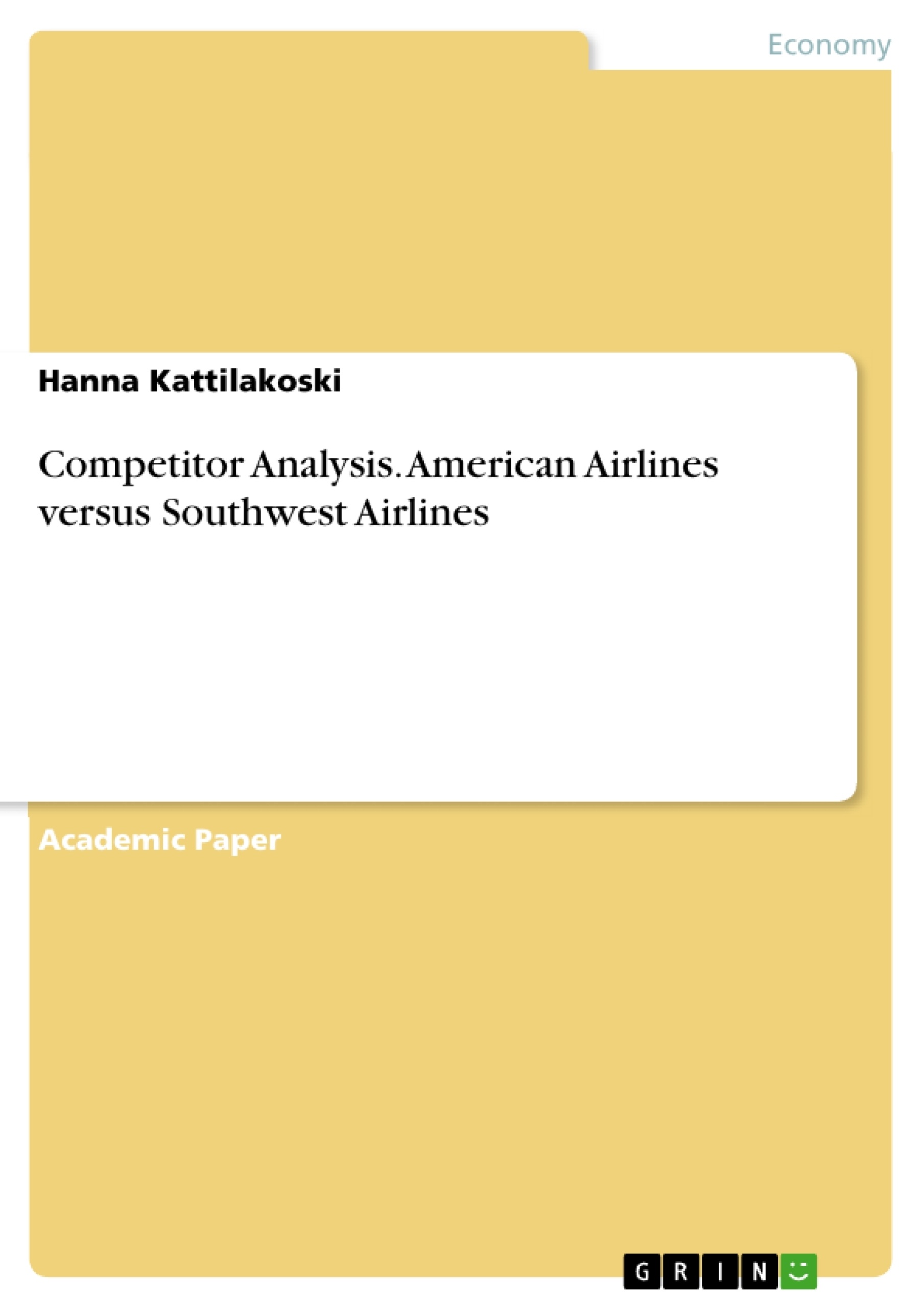Competitive intelligence is the process of monitoring an industry to identify current and future competitors, their activities, how their actions will affect a firm and how the firm should respond to these actions (Business Dictionary, 2017). The scope of this competitor analysis will be on examining a primary competitor for American Airlines, from which the results can help make strategic decisions in the future. Being aware of competition can help a company maintain their competitive advantage or their position in the market. The chosen competitor for American Airlines is Southwest Airlines. Within this paper, the background of both companies will be discussed, with a deep-dive into Southwest strategy as well as other key information. Two competitive intelligence techniques will be applied: Porters Five Forces and Scenario Analysis. Lastly, some predications about the future of the company will be made.
Table of Contents
- 1 Introduction
- 1.1 Overview of American Airlines
- 1.2 Overview of Southwest Airlines
- 1.3 Justification for Analysis of Southwest
- 2 Background Information
- 2.1 History
- 2.2 Sales Overview
- 2.2.1 Product Line
- 2.2.2 Key Sales Channels
- 2.2.3 Marketing
- 2.3 Market Overview
- 2.4 Partnerships
- 2.5 Competitors of Southwest
- 2.6 The Southwest Business Model
- 2.7 Management Information & Key Ownership
- 2.8 Employees
- 2.9 Financial Information
- 3 Perception of Southwest Airlines
- 3.1 Perception by Media
- 3.2 Perception by Customers
- 4 Competitive Intelligence Analysis
- 4.1 Scenario Analysis
- 4.2 Five Forces Analysis
- 5 Prediction of the Future
- 5.1 Expansion of Products
- 5.2 Customer Outlook
- 5.3 Expansion to International Markets
- 6 Conclusions
- 7 References
- 8 Appendix
Objectives and Key Themes
This competitor analysis aims to examine Southwest Airlines as a primary competitor to American Airlines, providing insights for future strategic decision-making. By understanding Southwest's strategies and key information, American Airlines can better maintain its competitive advantage. The analysis employs Porter's Five Forces and Scenario Analysis to achieve this objective.
- Competitive analysis of Southwest Airlines relative to American Airlines
- Examination of Southwest Airlines' business model and strategies
- Assessment of Southwest's market position and future growth potential
- Application of competitive intelligence techniques (Porter's Five Forces and Scenario Analysis)
- Prediction of future market trends and their impact on both airlines
Chapter Summaries
1 Introduction: This chapter introduces the concept of competitive intelligence and its importance in strategic decision-making. It establishes Southwest Airlines as the primary competitor for analysis in relation to American Airlines. The chapter lays out the structure of the paper, outlining the background information to be discussed, the competitive intelligence techniques to be applied (Porter's Five Forces and Scenario Analysis), and the future predictions that will be made. The importance of understanding competition to maintain a company's market position is emphasized.
2 Background Information: This chapter provides essential background information on Southwest Airlines, covering its history, sales, market overview, partnerships, competitors, business model, management, employees, and financial information. It aims to give a comprehensive understanding of Southwest’s position within the airline industry and its key characteristics. Understanding these aspects is crucial for a thorough competitive analysis.
Southwest Airlines Competitor Analysis: Frequently Asked Questions
What is the purpose of this document?
This document is a comprehensive competitor analysis of Southwest Airlines, focusing on its relevance to American Airlines. The goal is to provide insights for strategic decision-making at American Airlines by examining Southwest's business model, strategies, market position, and future potential.
What methodologies are used in this analysis?
The analysis utilizes two key methodologies: Porter's Five Forces and Scenario Analysis. These frameworks help to assess Southwest's competitive landscape and predict future market trends.
What information is included in the analysis?
The analysis covers a wide range of topics, including:
- An overview of both American Airlines and Southwest Airlines.
- The history and background of Southwest Airlines.
- Southwest's sales overview, including product lines, sales channels, and marketing strategies.
- A market overview, detailing Southwest's competitors and partnerships.
- A detailed examination of Southwest's business model.
- Southwest's management information, key ownership, employee details, and financial information.
- Public perception of Southwest Airlines, considering both media and customer perspectives.
- A competitive intelligence analysis using Porter's Five Forces and Scenario Analysis.
- Predictions about Southwest's future, including product expansion, customer outlook, and international market expansion.
- Concluding remarks summarizing the key findings.
What are the key themes explored in the analysis?
The key themes center around understanding Southwest's competitive advantage, its business model, its market position, and its potential for future growth. The analysis aims to identify key strengths and weaknesses to inform American Airlines' strategic planning.
What are the key objectives of this analysis?
The main objectives are to:
- Conduct a thorough competitive analysis of Southwest Airlines compared to American Airlines.
- Analyze Southwest's business model and strategies.
- Assess Southwest's current market position and its potential for future growth.
- Apply and demonstrate the use of competitive intelligence techniques (Porter's Five Forces and Scenario Analysis).
- Predict future market trends and their potential impact on both airlines.
How is the information organized?
The document is structured into several chapters, beginning with an introduction, followed by background information on Southwest Airlines, an analysis of its public perception, a competitive intelligence analysis, future predictions, conclusions, references, and an appendix.
What is the significance of the chapter summaries?
The chapter summaries provide a concise overview of the key topics and findings discussed in each section of the report, allowing for a quick grasp of the main points and facilitating easier navigation through the document.
For whom is this analysis intended?
This analysis is primarily intended for strategic decision-makers at American Airlines, providing them with valuable insights into a key competitor and aiding in their strategic planning processes.
- Quote paper
- Hanna Kattilakoski (Author), 2017, Competitor Analysis. American Airlines versus Southwest Airlines, Munich, GRIN Verlag, https://www.grin.com/document/542210




